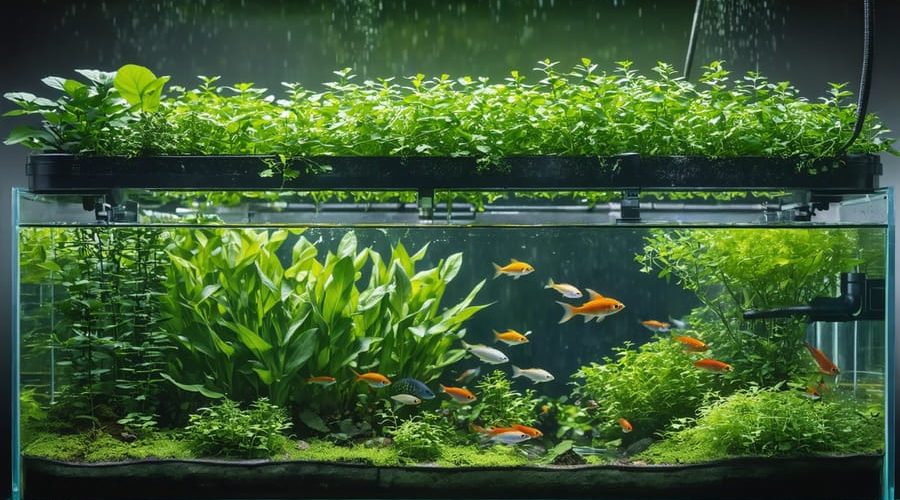
Build Your Dream Aquaponics System: A Sustainable Fish and Garden Paradise
Transform your backyard into a sustainable food production system with a DIY aquaponics setup that combines fish farming with soilless plant cultivation. Aquaponic systems design merges ancient agricultural wisdom with modern efficiency, creating a closed-loop ecosystem where fish waste nourishes plants, while plants naturally filter water for the fish. This revolutionary growing method uses 90% less water than traditional gardening while producing up to six times more food per square foot. Whether you’re a sustainability enthusiast, home gardener, or future commercial grower, understanding the core principles of aquaponics system design opens the door to year-round organic food production. From selecting the right fish species and plant combinations to calculating optimal flow rates and nutrient cycles, this guide will walk you through creating a thriving aquaponic ecosystem that fits your space and goals.
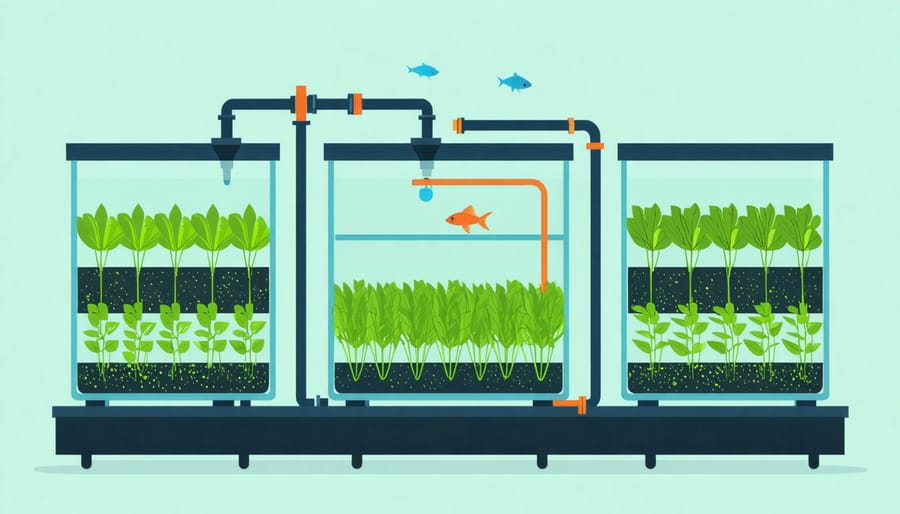
Essential Components of an Aquaponics System
Fish Tank Design and Sizing
When designing your fish tank, size matters! A good rule of thumb is to allow 5-10 gallons of water per pound of adult fish you plan to raise. For a home system, a tank between 100-300 gallons usually works well, providing enough space for the fish to thrive while maintaining stable water conditions.
The tank shape also plays a crucial role. While round tanks promote better water circulation, rectangular tanks are more space-efficient and easier to integrate into most setups. Choose a tank depth between 18-36 inches – this gives fish enough vertical swimming space while ensuring good oxygen distribution throughout the water column.
Consider your fish species when sizing the tank. Tilapia, a popular choice for aquaponics, need about 3 gallons per fish, while larger species like bass require more space. The tank material should be food-safe and durable – food-grade plastic, fiberglass, or glass are excellent options.
Remember to factor in space for filtration equipment and easy access for maintenance. Position your tank where it’s protected from extreme temperatures and direct sunlight to maintain stable water conditions.
Growing Bed Options
Growing beds are the heart of your aquaponics system, and choosing the right type can make a huge difference in your success. Media-filled beds, using materials like expanded clay pebbles or gravel, are perfect for beginners. They’re sturdy, provide excellent filtration, and support a wide variety of plants. Plus, they’re forgiving if you make small mistakes in water flow or nutrient levels.
Deep water culture (DWC) beds, where plants float on rafts directly above the water, offer excellent space efficiency and are great for leafy greens. While they require more precise monitoring, they’re easier to harvest and maintain. NFT systems (Nutrient Film Technique) use shallow channels with a thin film of water flowing through them. They’re ideal for smaller plants and herbs but need careful monitoring to prevent pump failures.
Vertical growing beds are becoming increasingly popular for urban gardeners, maximizing space by growing upward. However, they require more complex plumbing and careful weight distribution. Whichever style you choose, ensure it matches your space, maintenance capacity, and the types of plants you want to grow.
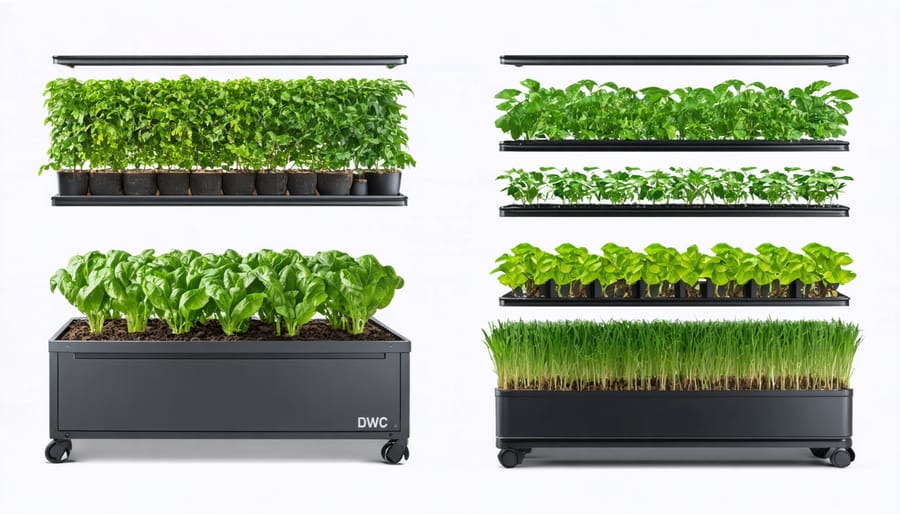
Filtration and Plumbing
A well-designed filtration system is crucial for maintaining healthy water quality in your aquaponics setup. The main components include mechanical filters to remove solid waste, biological filters where beneficial bacteria convert ammonia to nitrates, and pumps to keep water flowing. For most home systems, a combination of filter sponges and bio-balls works well for mechanical and biological filtration. Your plumbing should include both supply and drain lines, typically using PVC pipes of 1-2 inches in diameter. Install valves at key points to control water flow and make maintenance easier. Consider adding a settling tank before the main filter to catch larger debris, and ensure your pump is sized correctly for your system’s volume – a good rule of thumb is cycling your total water volume at least once per hour.
Planning Your Layout
Space Requirements
Calculating the right space for your aquaponics system is crucial for success. A good rule of thumb is to maintain a ratio of 1:1 between your grow bed and fish tank areas. For beginners, start with at least 100 gallons of fish tank volume matched with 100 square feet of growing space.
When planning your layout, remember to account for walking spaces and maintenance access. Leave at least 2-3 feet of clearance around your system for comfortable movement and easy maintenance. If you’re setting up indoors, factor in ceiling height – most plants need at least 18-24 inches of vertical growing space, plus room for lighting fixtures if you’re using artificial light.
Consider your available space constraints before choosing a system design. Vertical systems are perfect for small spaces, allowing you to stack growing beds and maximize production in a minimal footprint. For example, a 10×10 foot area can support a vertical system with up to 200 square feet of growing space.
Don’t forget to plan space for essential components like filters, pumps, and plumbing. These typically need about 10-15% of your total system footprint. If you’re including a sump tank, add another 20% to your space calculations.
Temperature control is also space-dependent. Indoor systems need less space for insulation, while outdoor systems might require additional room for greenhouse structures or shade cloth supports. Always plan for future expansion – it’s better to have a bit of extra space than to feel cramped later on.
Remember to check local building codes and zoning regulations, as these might affect where you can place your system and how much space you can use.
System Configurations
Aquaponic systems come in various configurations to suit different spaces and needs. The most popular setup is the Media Bed system, perfect for beginners and home gardeners. This design uses grow beds filled with materials like expanded clay or gravel, supporting both the plants and beneficial bacteria. It’s ideal for small spaces and can be as compact as 4×4 feet.
For those with more room, the Nutrient Film Technique (NFT) system offers excellent space efficiency. Plants grow in long channels with their roots exposed to a thin film of nutrient-rich water. This setup works wonderfully for leafy greens and herbs, making it popular for indoor setups and vertical farming.
Deep Water Culture (DWC) or raft systems are fantastic for commercial-scale operations but can be adapted for home use. Plants float on rafts in deep tanks of water, while fish live separately below. This design is easy to maintain and provides stable growing conditions for both fish and plants.
For urban gardeners, vertical systems maximize limited space by growing upward instead of outward. Tower systems can fit in corners or against walls, while A-frame designs create an attractive garden feature while producing food. These systems typically combine different growing methods, with fish tanks at the base and plants arranged in tiers above.
Hybrid systems blend two or more configurations to maximize benefits. For example, combining media beds for root crops with NFT channels for leafy greens allows for diverse crop production in a single system.
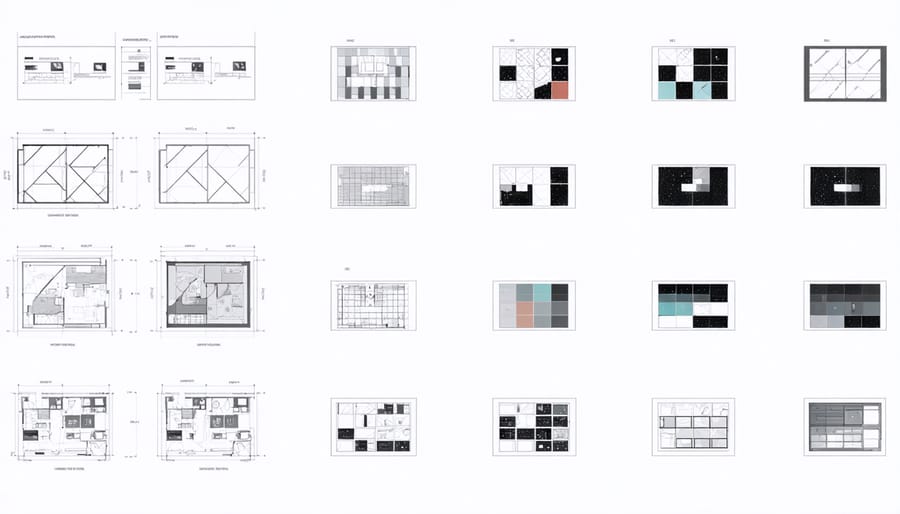
Water Flow and Circulation
Pump Selection
Selecting the right pump is crucial for your aquaponics system’s success. A properly sized pump ensures efficient water circulation while keeping energy costs manageable. To choose the right pump, first calculate your system’s total water volume and determine how many times per hour you want to cycle that water through your system – typically once per hour is recommended for most setups.
For small home systems under 100 gallons, a submersible pump rated between 250-500 gallons per hour (GPH) usually works well. Medium-sized systems between 100-500 gallons typically need pumps rated for 500-1000 GPH. Remember that your actual flow rate will be less than the pump’s rating due to head height (vertical distance the water must travel) and friction loss in pipes.
When shopping for pumps, look for energy-efficient models with adjustable flow rates. This allows you to fine-tune the water flow as your system matures. Consider getting a slightly larger pump than your calculations suggest, as it’s easier to reduce flow than to deal with insufficient water movement.
Important features to look for include:
– Low energy consumption
– Reliable brand reputation
– Easy maintenance access
– Built-in pre-filter
– Weather resistance for outdoor use
– Quiet operation
Don’t forget to factor in your climate – if you’re in a colder region, you’ll want a pump that can handle continuous operation without overheating or freezing.
Flow Rate Calculations
Getting the right flow rate in your aquaponics system is crucial for both your plants and fish. A good rule of thumb is to aim for cycling your total water volume through your system once every hour. For example, if you have a 100-gallon system, you’ll want a pump that can move 100 gallons per hour.
To calculate your needed flow rate, first measure your total water volume, including fish tanks and grow beds. Then, consider these factors:
For fish tanks:
– Small fish need gentler flow (2-3 tank turnovers per hour)
– Larger fish tolerate stronger currents (4-5 turnovers per hour)
– Ensure enough oxygenation without stressing the fish
For grow beds:
– Media-filled beds need complete flooding every 15-20 minutes
– NFT channels require 1-2 liters per minute
– Deep water culture needs gentle, constant movement
Remember that actual flow rates might need adjustment based on:
– Plant types and growth stages
– Fish species and population
– Water temperature
– System design
Start with the calculated rate and observe your system. If plants show signs of nutrient deficiency or fish seem stressed, adjust accordingly. It’s better to start with slightly lower flow rates and increase them gradually as needed.
Pro tip: Install adjustable valves to fine-tune flow rates to different parts of your system. This gives you more control and helps optimize performance over time.
Plant and Fish Selection
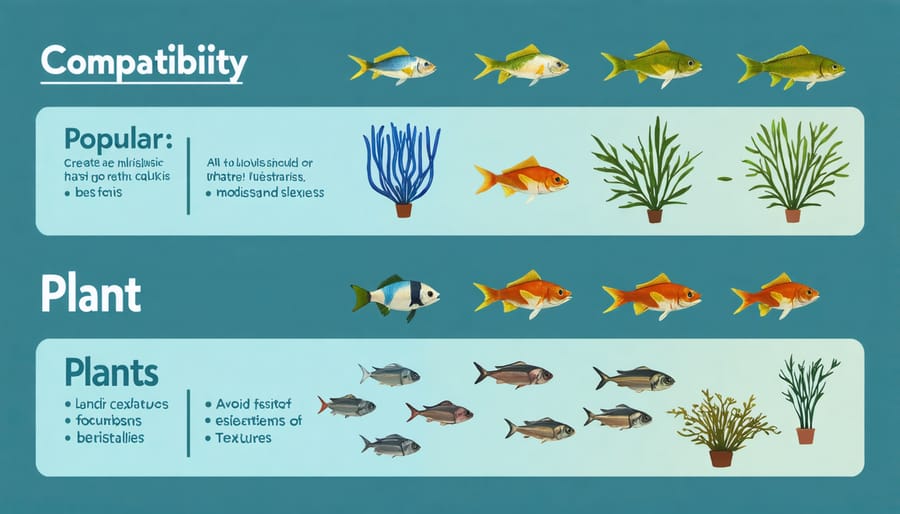
Best Fish Species
When starting your aquaponics journey, choosing the right fish species is crucial for success. Tilapia is often considered the perfect beginner’s fish due to its hardiness, fast growth rate, and adaptability to various water conditions. These fish are easy to care for and can tolerate fluctuations in water quality while you’re learning the ropes.
Another excellent choice for newcomers is catfish, particularly channel catfish. They’re robust, disease-resistant, and can thrive in slightly cooler waters. Catfish are also great at converting feed into body mass, making them an efficient choice for your system.
For those in cooler climates, rainbow trout can be an exciting option. While they require more precise water temperature control (preferably between 50-60°F), they offer excellent growth rates and delicious meat. Just remember that trout need highly oxygenated water and cleaner conditions than other species.
Bluegill and other sunfish species are also worth considering for beginners. These native North American fish are naturally hardy and adapt well to aquaponics systems. They’re smaller than tilapia but still provide good growth rates and can handle a wider temperature range.
Goldfish and koi can work well in systems where eating the fish isn’t the primary goal. They’re extremely hardy, produce plenty of nutrients for plants, and add beautiful colors to your system. However, they grow more slowly than food fish species.
Ideal Plants
Several plants thrive exceptionally well in aquaponic systems, making them perfect choices for your setup. Leafy greens are among the most successful, with lettuce, spinach, and kale being top performers. These plants grow quickly and don’t require high nutrient levels, making them ideal for beginners.
Herbs are another excellent choice, with basil, mint, and parsley flourishing in aquaponic environments. These plants not only grow well but also provide continuous harvests as you trim what you need while leaving the plant to keep producing.
For those looking to grow larger plants, tomatoes and cucumbers can be very productive in aquaponic systems. However, these plants require more substantial support structures and higher nutrient levels, so they’re better suited for established systems.
Root vegetables like radishes and beets can also be grown successfully, though they need specialized growing beds with adequate depth. Strawberries are another popular choice, especially in floating raft systems where their runners can be easily managed.
When selecting plants, consider your system’s size and nutrient capacity. Start with easy-to-grow options like lettuce and herbs, then gradually experiment with more demanding plants as you gain experience. Remember that plants with similar nutrient needs should be grouped together for optimal growth and system efficiency.
Monitoring and Maintenance
Water Quality Parameters
Regular water quality testing is essential for a thriving aquaponics system. The key parameters you’ll need to monitor include pH (aim for 6.8-7.2), ammonia (should be near zero), nitrites (also near zero), and nitrates (between 5-150 ppm). Temperature is equally important, with most systems performing best between 18-24°C (65-75°F).
Start your testing routine with a basic water testing kit from your local aquarium store. Test your water at least weekly, preferably at the same time each day for consistency. Keep a logbook to track changes – this will help you spot potential issues before they become problems.
Dissolved oxygen levels should stay above 5 ppm to keep both fish and plants healthy. A simple way to check this is to observe your fish – if they’re swimming normally and not gasping at the surface, oxygen levels are likely adequate. Test more frequently during warm weather or when adding new fish to your system.
Remember, healthy water means healthy fish and plants. If any parameter seems off, make adjustments gradually to avoid stressing your system.
Regular Maintenance Tasks
To keep your aquaponics system thriving, follow these essential maintenance routines. Daily tasks include checking water temperature, pH levels, and ensuring all pumps are running smoothly. Feed your fish at scheduled times and remove any floating debris or dead plant matter from the grow beds.
Weekly maintenance involves testing ammonia and nitrate levels, cleaning filters, and inspecting plant roots for signs of disease. Check for any plumbing leaks and ensure water flow is consistent throughout the system. Prune plants as needed and remove any yellowing leaves.
Monthly tasks are more intensive but crucial for system health. Clean out and rinse your bio-filter media, check and calibrate all monitoring equipment, and deep clean settling tanks. Inspect fish for any signs of illness and maintain detailed records of water quality parameters. Clean any mineral buildup from pipes and adjust your system’s plumbing if necessary.
Remember to keep a maintenance log to track patterns and potential issues. This helps you stay proactive and ensures your system runs efficiently year-round. As you become familiar with your setup, you’ll develop an intuitive understanding of when additional maintenance might be needed.
As we’ve explored throughout this guide, aquaponic systems offer an incredible opportunity to create a sustainable, productive ecosystem right in your own space. By combining fish cultivation with soil-less plant growing, you’re not just creating a garden – you’re participating in a revolution in sustainable food production.
Remember that successful aquaponics is all about balance. Start with the basics we’ve covered: properly sized tanks, appropriate fish-to-plant ratios, and reliable filtration systems. Take time to plan your layout carefully, considering factors like space, light availability, and accessibility for maintenance.
Don’t feel overwhelmed by the technical aspects – everyone starts somewhere! Begin with a small system if you’re new to aquaponics, and expand as your confidence grows. The beauty of these systems is that they can be as simple or complex as you choose to make them.
The most important things to keep in mind are maintaining water quality, choosing compatible fish and plants, and establishing a regular maintenance routine. Keep track of your system’s performance, learn from any challenges you encounter, and adjust as needed.
Whether you’re looking to grow fresh vegetables year-round, raise your own fish, or simply create a fascinating living ecosystem, aquaponics offers endless possibilities. The initial setup might require some effort, but the rewards – fresh produce, healthy fish, and the satisfaction of creating a sustainable food system – are well worth it.
So why wait? Take what you’ve learned here and start planning your aquaponics adventure. Remember, every expert was once a beginner, and the aquaponics community is always ready to help fellow enthusiasts succeed.
